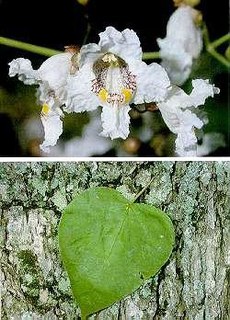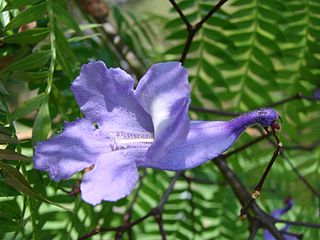Related Research Articles

Catalpa, commonly called catalpa or catawba, is a genus of flowering plants in the family Bignoniaceae, native to warm temperate and subtropical regions of North America, the Caribbean, and East Asia.

Lantana ( ) is a genus of about 150 species of perennial flowering plants in the verbena family, Verbenaceae. They are native to tropical regions of the Americas and Africa but exist as an introduced species in numerous areas, especially in the Australian-Pacific region, South and Northeastern part of India. The genus includes both herbaceous plants and shrubs growing to 0.5–2 m (1.6–6.6 ft) tall. Their common names are shrub verbenas or lantanas. The generic name originated in Late Latin, where it refers to the unrelated Viburnum lantana.

Rhamnaceae is a large family of flowering plants, mostly trees, shrubs, and some vines, commonly called the buckthorn family. Rhamnaceae is included in the order Rosales.

Jacaranda is a genus of 49 species of flowering plants in the family Bignoniaceae, native to tropical and subtropical regions of Latin America and the Caribbean.

Plumeria is a genus of flowering plants in the family Apocynaceae. Most species are deciduous shrubs or small trees. The species variously are endemic to Mexico, Central America and the Caribbean, and as far south as Brazil and north as Florida, but are grown as cosmopolitan ornamentals in warm regions. Common names for plants in the genus vary widely according to region, variety, and whim, but frangipani or variations on that theme are the most common. Plumeria is also used as a common name, especially in horticultural circles.

Manilkara is a genus of trees in the family Sapotaceae. They are widespread in tropical and semitropical locations, in Africa, Madagascar, Asia, Australia, and Latin America, as well as various islands in the Pacific and in the Caribbean. A close relative is the genus Pouteria.

Myrica is a genus of about 35–50 species of small trees and shrubs in the family Myricaceae, order Fagales. The genus has a wide distribution, including Africa, Asia, Europe, North America and South America, and missing only from Australia. Some botanists split the genus into two genera on the basis of the catkin and fruit structure, restricting Myrica to a few species, and treating the others in Morella.

Caesalpinia is a genus of flowering plants in the legume family, Fabaceae. Historically, membership within the genus has been highly variable, with different publications including anywhere from 70 to 165 species, depending largely on the inclusion or exclusion of species alternately listed under genera such as Hoffmannseggia. It contains tropical or subtropical woody plants. The generic name honours the botanist, physician, and philosopher Andrea Cesalpino (1519–1603).

Koncordie Amalie Dietrich was a German naturalist who was best known for her pioneering work in Australia from 1863 to 1872, collecting specimens for the Museum Godeffroy in Hamburg.

Pimenta is a genus of flowering plants in the myrtle family, Myrtaceae described as a genus in 1821. It is native to Central and South America, Mexico, and the West Indies.

Sideroxylon is a genus of trees in the family Sapotaceae described as a genus by Linnaeus in 1753. They are collectively known as bully trees. The generic name is derived from the Greek words σιδηρος (sideros), meaning "iron", and ξύλον (xylon), meaning "wood."
White snakeroot is a common name for several flowering plants in the aster family, Asteraceae, and may refer to:

The San Juan Botanical Garden, also known as the Botanical Garden of the University of Puerto Rico, is located in the Caribbean city of San Juan, capital of Puerto Rico. This lush 300-acre (1.2 km2) “urban garden” of native and exotic flora serves as a laboratory for the study, conservation and enrichment of plants, trees, flowers, grasses and many other plants. Seventy-five acres are landscaped and open to the general public as well as researchers.

Henriettea is a genus of flowering plants in the family Melastomataceae, with some 68 species accepted. It is distributed in the Americas. Some species in the genus are known commonly as camasey.

Maytenus is a genus of flowering plants in the family Celastraceae. Members of the genus are distributed throughout Central and South America, Southeast Asia, Micronesia and Australasia, the Indian Ocean and Africa. They grow in a very wide variety of climates, from tropical to subpolar. In 2017, a taxonomic review moved 123 species of Maytenus to a new genus, called Monteverdia.
Feddea is a genus of flowering plants in the daisy family.
Herodotia is a genus of flowering plants in the daisy family.
Selleophytum is a genus of flowering plants in the tickseed tribe within the daisy family.
Koehneola is a genus of flowering plants in the daisy family.

Anaphalis triplinervis is an Asian species of flowering herbaceous perennial plant in the sunflower family, native to the Himalayas. Grey-green felted leaves produce sprays of small white flower heads.
References
- ↑ Urban, Ignatz. 1931. Arkiv för Botanik utgivet av K. Svenska Vetenskapsakademien 23A(11): 90
- ↑ Tropicos, Mattfeldia Urb.
- ↑ Flann, C (ed) 2009+ Global Compositae Checklist Archived 2014-12-18 at Archive.today
- ↑ The Plant List, Mattfeldia triplinervis Urb.
- ↑ The International Plant Names Index